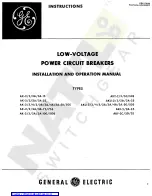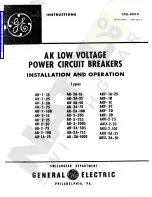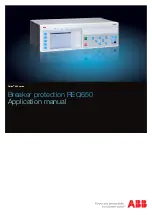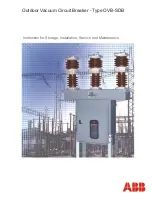
26
Load capacity of interlocking shaft
Interdependence between torque on the interlocking shaft and turning angle of the shaft when switching modu-
le has been previously switched off is presented on figure 36. Peak values of the torque are from 0.56 to 0.84 Nm.
When shaft is rotated counter-clockwise the interlocking unit is moved from “Unlatched” position to “Open and
locked” one, and otherwise. Operation zone of microswitch S14 when it becomes closed or open in “Unlatched” or
“Open and Locked” positions respectively is hatched.
If switching module is closed before rotation of the interlocking shaft and manual trip operation is fulfilled the peak
value of the torque can be up to 2Nm.
Electrical Interlocking
Electrical interlocking is also coupled with the interlocking shaft rotation (refer to chapter “Switching and control
functions/Internal electrical interlock”, page 38). If the mechanical interlocking is effective, then the electrical
interlocking contact is activated synchronously. Electrical interlocking occurs during first 10 degree of interlocking
shaft rotation whereby actuator coils are disconnected from the control module.
Main Contacts Position Indicator
The position indicator works as follows. There are two runners on the synchronizing shaft, any can be chosen to
activate movable part of indicator, attached to wire. The movable part has a sticker with two printed symbols, one for
Open position of the switching module, the other for Closed one. Connection of control wire to runner is described in
“How position indicator can be attached and mounted” in detail.
When switching module comes to Open position the runner pulls the wire and corresponding symbol in inspection
window becomes visible (see figure 44). When switching module comes to Close position the spring in the indica-
tor provides reverse movement of the wire and symbol is changed to that one shown on figure 45.
Figure 36
Torque on the interlocking shaft
3
Summary of Contents for ISM Shell_2 Series
Page 2: ...2...
Page 6: ...6 1 THIS PAGE INTENTIONALLY LEFT BLANK...
Page 7: ...7 Introduction 1...
Page 12: ...12 1 THIS PAGE INTENTIONALLY LEFT BLANK...
Page 13: ...13 Receiving Handling and Storage 2...
Page 19: ...19 Ins tallation 3...
Page 36: ...36 3 THIS PAGE INTENTIONALLY LEFT BLANK...
Page 37: ...37 Switching and Control Functions 4...
Page 41: ...41 Commiss ioning Maintenance 5...
Page 44: ...44 5 THIS PAGE INTENTIONALLY LEFT BLANK...
Page 45: ...45 Signalling 6...
Page 49: ...49 Special Applications Fast Switching 6...
Page 53: ...53 Product Line 7...
Page 55: ...55 Dimens ions and Weights 8...
Page 61: ...61 8 Mating part with interlocking lever Interlockingshaftwithmountedinterlockinglever...
Page 62: ...62 Circuit Diagrams 9...
Page 63: ...63 ISM15_Shell_2 with CM_1501_01 9...
Page 64: ...64 ISM15_Shell_2 with CM_16_1 9...
Page 65: ...65 9 THIS PAGE INTENTIONALLY LEFT BLANK...
Page 66: ...66 Technical Data 10...
Page 71: ...71 10 THIS PAGE INTENTIONALLY LEFT BLANK...
Page 72: ...72 Regulations and Ambient Conditions 11...
Page 74: ...74 Legal Information 12...
Page 77: ...77 12 THIS PAGE INTENTIONALLY LEFT BLANK...
Page 79: ...79 Date 12...
Page 80: ...80 Date 12...
Page 81: ...81 Date 12...
















































